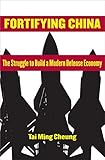Fortifying China : The Struggle to Build a Modern Defense Economy / Tai Ming Cheung.
Material type: TextPublisher: Ithaca, NY : Cornell University Press, [2013]Copyright date: ©2013Description: 1 online resource (296 p.) : 18 tables, 6 charts/graphsContent type:
TextPublisher: Ithaca, NY : Cornell University Press, [2013]Copyright date: ©2013Description: 1 online resource (296 p.) : 18 tables, 6 charts/graphsContent type: - 9780801446924
- 9780801468506
- 338.4/735500951
- online - DeGruyter
- Issued also in print.
| Item type | Current library | Call number | URL | Status | Notes | Barcode | |
|---|---|---|---|---|---|---|---|
 eBook
eBook
|
Biblioteca "Angelicum" Pont. Univ. S.Tommaso d'Aquino Nuvola online | online - DeGruyter (Browse shelf(Opens below)) | Online access | Not for loan (Accesso limitato) | Accesso per gli utenti autorizzati / Access for authorized users | (dgr)9780801468506 |
Browsing Biblioteca "Angelicum" Pont. Univ. S.Tommaso d'Aquino shelves, Shelving location: Nuvola online Close shelf browser (Hides shelf browser)

|

|

|

|

|

|

|
||
| online - DeGruyter A Grand Strategy for America / | online - DeGruyter Japan Prepares for Total War : The Search for Economic Security, 1919–1941 / | online - DeGruyter Renovating Russia : The Human Sciences and the Fate of Liberal Modernity, 1880–1930 / | online - DeGruyter Fortifying China : The Struggle to Build a Modern Defense Economy / | online - DeGruyter The Age of Reformation / | online - DeGruyter The Sources of Military Doctrine : France, Britain, and Germany Between the World Wars / | online - DeGruyter Myths of Empire : Domestic Politics and International Ambition / |
Frontmatter -- Contents -- Preface and Acknowledgments -- Abbreviations -- 1. Bridging the Civil-Military Technological Divide in the Information Age -- 2. Innovation and Stagnation during the Maoist Era -- 3. The Eclipse of the Defense Economy under Deng Xiaoping -- 4. The Revival of the Defense Economy in the Twenty-first Century -- 5. Building a Dual-Use Economy -- 6. Can the Chinese Defense Economy Catch Up? -- Chinese Terms -- Historical Official Exchange Rates between the Renminbi and U.S. Dollar, 1955-2008 -- Select Chinese-Language Bibliography -- Index
restricted access online access with authorization star
http://purl.org/coar/access_right/c_16ec
Fortifying China explores the titanic struggle to turn China into an aspiring world-class military technological power. The defense economy is leveraging the country's vibrant civilian economy and gaining access to foreign sources of technology and know-how. Drawing on extensive Chinese-language sources, Tai Ming Cheung explains that this transformation has two key dimensions. The defense economy is being reengineered to break down bureaucratic barriers and reduce the role of the state, fostering a more competitive and entrepreneurial culture to facilitate the rapid diffusion and absorption of technology and knowledge. At the same time, the civilian and defense economies are being integrated to form a dual-use technological and industrial base.In Cheung's view, the Chinese authorities believe this strategy will play a key role in supporting long-term defense modernization. For China's neighbors and the United States, understanding China's technological, industrial, and military capabilities is critical to the formulation of economic and security policies. Fortifying China provides crucial insight into the impact of China's dual-use technology strategy. Cheung's "systems of innovation" framework considers the structure, dynamics, and performance of the defense economy from a systems-level perspective.
Issued also in print.
Mode of access: Internet via World Wide Web.
In English.
Description based on online resource; title from PDF title page (publisher's Web site, viewed 02. Mrz 2022)


